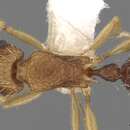en
names in breadcrumbs


Taxonomic history
Bolton, 1979 PDF: 174 (w.).See also: Bolton, 1977 PDF: 79.(Fig. 59)
Tetramorium {Xiphomyrmex) belgaense Forel , 1902: 238. Holotype female, India: Mysore, Belgaum (Wroughton) (MHN, Geneva) [examined].
Worker (previously undescribed). TL 3.3 - 4.0, HL 0.74 - 0.80, HW 0.66 - 0.70, CI 87 - 89, SL 0.58 - 0.64, SI 88 - 92, PW 0.52 - 0.58, AL 0.90 - 1.00 (10 measured).
Antennae with 11 segments. Mandibles finely longitudinally striate. Anterior clypeal margin entire, without a median notch or impression. Frontal carinae long, reaching back almost to occiput and distinctly more strongly developed than other cephalic sculpture. Eyes relatively large, maximum diameter 0.19 - 0.21, about 0.28 - 0.30 x HW. Alitrunk in profile with the dorsum evenly convex, the propodeal spines long and narrow, feebly upcurved along their length, twice as long as the acutely triangular metapleural lobes. Petiole in profile with a roughly rectangular node, the anterior face vertical and meeting the shallowly convex dorsum in a blunt right-angle. Posterodorsal angle of node distinctly more rounded than antero-dorsal. Postpetiole in profile high and narrow, the tergum higher than long. Dorsum of head with widely spaced sharp longitudinal rugae with sparse cross-meshes which are less strongly developed and with a narrow reticulum occipitally. Dorsal alitrunk reticulate-rugose, the petiole dorsum similarly but less strongly sculptured. Postpetiole dorsally with a median strip which is punctulate or unsculptured but this is flanked on each side by rugulose sculpture. Gaster unsculptured. All dorsal surfaces of head and body with numerous elongate erect hairs but the scapes and outer tibial surfaces only with fine pubescence. Colour light brown, the appendages yellow, the gaster darker than the head and alitrunk.
In the key to species (Bolton, 1977: 72) belgaense will run out at couplet 12 along with yerburyi Forel. The two are immediately separable as the Sri Lankan yerburyi is much larger (HW 0.94 - 1.04, PW 0.70 - 0.74) with relatively longer antennal scapes (SI 98 - 102). Apart from these mensurable characters yerburyi has long stout hairs projecting from the dorsal (outer) surface of the hind tibiae where only short pubescence is present in belgaense , and in yerburyi the metapleural lobes are low and blunt, very obtusely triangular at most, whereas in belgaense they are narrowly and acutely elongate-triangular.
In one respect it is difficult to fit belgaense into the key as its SI falls between the two limits given in couplet 8, where the first half has SI 75 - 86, and the second half 90 - 105. However, as the range of belgaense is 88 - 92 it was decided to run it through the second half of couplet 8 as its measured SI is above the upper level of the range given in the first half whilst its upper level is within the range given in the second half of the couplet.
Material examined
India: Mysore, 10 miles [23 km] S. Haliyal, 500 m, 16. ii. 1962 (E. S. Ross & D. Cavagnaro).